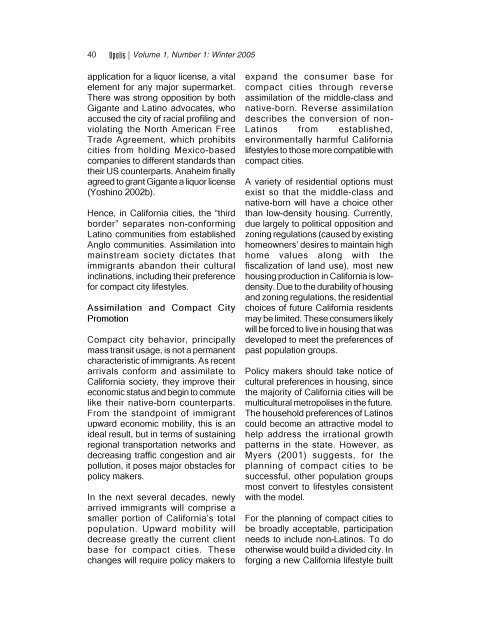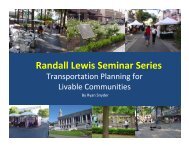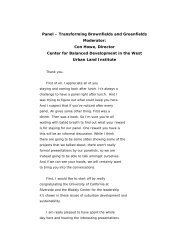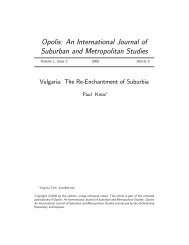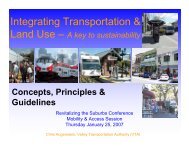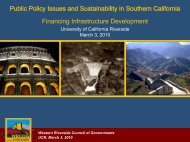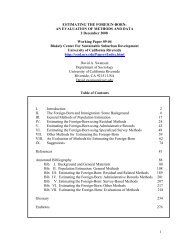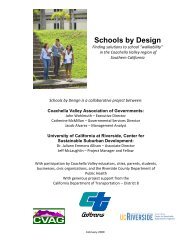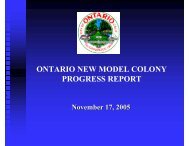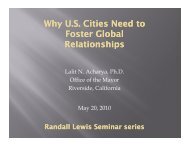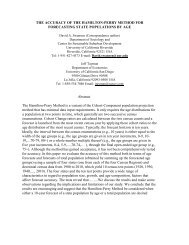Latino New Urbanism: Building on Cultural Preferences - Center for ...
Latino New Urbanism: Building on Cultural Preferences - Center for ...
Latino New Urbanism: Building on Cultural Preferences - Center for ...
Create successful ePaper yourself
Turn your PDF publications into a flip-book with our unique Google optimized e-Paper software.
40 Opolis | Volume 1, Number 1: Winter 2005<br />
applicati<strong>on</strong> <strong>for</strong> a liquor license, a vital<br />
element <strong>for</strong> any major supermarket.<br />
There was str<strong>on</strong>g oppositi<strong>on</strong> by both<br />
Gigante and <str<strong>on</strong>g>Latino</str<strong>on</strong>g> advocates, who<br />
accused the city of racial profiling and<br />
violating the North American Free<br />
Trade Agreement, which prohibits<br />
cities from holding Mexico-based<br />
companies to different standards than<br />
their US counterparts. Anaheim finally<br />
agreed to grant Gigante a liquor license<br />
(Yoshino 2002b).<br />
Hence, in Cali<strong>for</strong>nia cities, the “third<br />
border” separates n<strong>on</strong>-c<strong>on</strong><strong>for</strong>ming<br />
<str<strong>on</strong>g>Latino</str<strong>on</strong>g> communities from established<br />
Anglo communities. Assimilati<strong>on</strong> into<br />
mainstream society dictates that<br />
immigrants aband<strong>on</strong> their cultural<br />
inclinati<strong>on</strong>s, including their preference<br />
<strong>for</strong> compact city lifestyles.<br />
Assimilati<strong>on</strong> and Compact City<br />
Promoti<strong>on</strong><br />
Compact city behavior, principally<br />
mass transit usage, is not a permanent<br />
characteristic of immigrants. As recent<br />
arrivals c<strong>on</strong><strong>for</strong>m and assimilate to<br />
Cali<strong>for</strong>nia society, they improve their<br />
ec<strong>on</strong>omic status and begin to commute<br />
like their native-born counterparts.<br />
From the standpoint of immigrant<br />
upward ec<strong>on</strong>omic mobility, this is an<br />
ideal result, but in terms of sustaining<br />
regi<strong>on</strong>al transportati<strong>on</strong> networks and<br />
decreasing traffic c<strong>on</strong>gesti<strong>on</strong> and air<br />
polluti<strong>on</strong>, it poses major obstacles <strong>for</strong><br />
policy makers.<br />
In the next several decades, newly<br />
arrived immigrants will comprise a<br />
smaller porti<strong>on</strong> of Cali<strong>for</strong>nia’s total<br />
populati<strong>on</strong>. Upward mobility will<br />
decrease greatly the current client<br />
base <strong>for</strong> compact cities. These<br />
changes will require policy makers to<br />
expand the c<strong>on</strong>sumer base <strong>for</strong><br />
compact cities through reverse<br />
assimilati<strong>on</strong> of the middle-class and<br />
native-born. Reverse assimilati<strong>on</strong><br />
describes the c<strong>on</strong>versi<strong>on</strong> of n<strong>on</strong>-<br />
<str<strong>on</strong>g>Latino</str<strong>on</strong>g>s from established,<br />
envir<strong>on</strong>mentally harmful Cali<strong>for</strong>nia<br />
lifestyles to those more compatible with<br />
compact cities.<br />
A variety of residential opti<strong>on</strong>s must<br />
exist so that the middle-class and<br />
native-born will have a choice other<br />
than low-density housing. Currently,<br />
due largely to political oppositi<strong>on</strong> and<br />
z<strong>on</strong>ing regulati<strong>on</strong>s (caused by existing<br />
homeowners’ desires to maintain high<br />
home values al<strong>on</strong>g with the<br />
fiscalizati<strong>on</strong> of land use), most new<br />
housing producti<strong>on</strong> in Cali<strong>for</strong>nia is lowdensity.<br />
Due to the durability of housing<br />
and z<strong>on</strong>ing regulati<strong>on</strong>s, the residential<br />
choices of future Cali<strong>for</strong>nia residents<br />
may be limited. These c<strong>on</strong>sumers likely<br />
will be <strong>for</strong>ced to live in housing that was<br />
developed to meet the preferences of<br />
past populati<strong>on</strong> groups.<br />
Policy makers should take notice of<br />
cultural preferences in housing, since<br />
the majority of Cali<strong>for</strong>nia cities will be<br />
multicultural metropolises in the future.<br />
The household preferences of <str<strong>on</strong>g>Latino</str<strong>on</strong>g>s<br />
could become an attractive model to<br />
help address the irrati<strong>on</strong>al growth<br />
patterns in the state. However, as<br />
Myers (2001) suggests, <strong>for</strong> the<br />
planning of compact cities to be<br />
successful, other populati<strong>on</strong> groups<br />
most c<strong>on</strong>vert to lifestyles c<strong>on</strong>sistent<br />
with the model.<br />
For the planning of compact cities to<br />
be broadly acceptable, participati<strong>on</strong><br />
needs to include n<strong>on</strong>-<str<strong>on</strong>g>Latino</str<strong>on</strong>g>s. To do<br />
otherwise would build a divided city. In<br />
<strong>for</strong>ging a new Cali<strong>for</strong>nia lifestyle built


